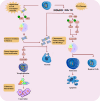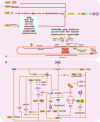Telomeres, telomerase, and cancer: mechanisms, biomarkers, and therapeutics
- PMID: 39871386
- PMCID: PMC11771031
- DOI: 10.1186/s40164-025-00597-9
Telomeres, telomerase, and cancer: mechanisms, biomarkers, and therapeutics
Abstract
Telomeres and telomerase play crucial roles in the initiation and progression of cancer. As biomarkers, they aid in distinguishing benign from malignant tissues. Despite the promising therapeutic potential of targeting telomeres and telomerase for therapy, translating this concept from the laboratory to the clinic remains challenging. Many candidate drugs remain in the experimental stage, with only a few advancing to clinical trials. This review explores the relationship between telomeres, telomerase, and cancer, synthesizing their roles as biomarkers and reviewing the outcomes of completed trials. We propose that changes in telomere length and telomerase activity can be used to stratify cancer stages. Furthermore, we suggest that differential expression of telomere and telomerase components at the subcellular level holds promise as a biomarker. From a therapeutic standpoint, combining telomerase-targeted therapies with drugs that mitigate the adverse effects of telomerase inhibition may offer a viable strategy.
Keywords: Cancer; Telomere shortening; Telomeres.
© 2025. The Author(s).
Conflict of interest statement
Declarations. Ethics approval and consent to participate: Not applicable. Consent for publication: Not applicable. Competing interests: The authors declare no competing interests.
Figures




References
-
- Bray F, Laversanne M, Weiderpass E, Soerjomataram I. The ever-increasing importance of cancer as a leading cause of premature death worldwide. Cancer. 2021;127:3029–30. - PubMed
-
- Crosby D, Bhatia S, Brindle KM, Coussens LM, Dive C, Emberton M, et al. Early detection of cancer. Science. 2022;375:eaay9040. - PubMed
Publication types
Grants and funding
- ZYYCXTD-C-202205/the Innovation Team and Talents Cultivation Program of National Administration of Traditional Chinese Medicine
- CI2021B009/the Scientific and Technological Innovation Project of China Academy of Chinese Medical Sciences
- HLCMHPP2023085/the High Level Chinese Medical Hospital Promotion Project
- HLCMHPP202308506/the High Level Chinese Medical Hospital Promotion Project
- HLCMHPP2023005/the High Level Chinese Medical Hospital Promotion Project
- 81774294/the National Natural Science Foundation of China
- 82104961/the National Natural Science Foundation of China
- ZZ14-YQ-016/the Fundamental Research Funds for the Central public welfare research institutes
- ZZ13-YQ-028/the Fundamental Research Funds for the Central public welfare research institutes
- CI2021A01816/CACMS Innovation Fund
- CI2021A01814/CACMS Innovation Fund
- CI2021A01805/CACMS Innovation Fund
LinkOut - more resources
Full Text Sources
Research Materials

